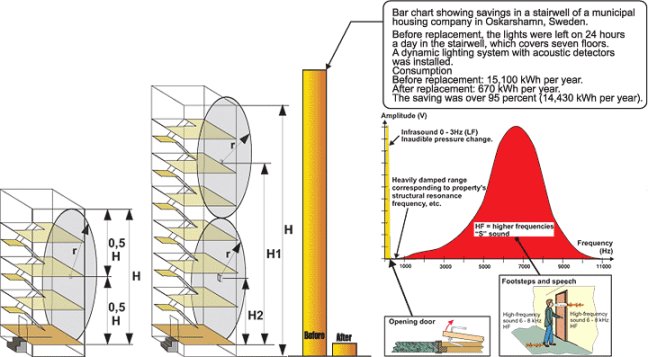4B. Stairwell with acoustic detector and dimmable HF operating devices, ‘Dynamic lighting Control’
Svenskt patent nr. 9201493-5, English patent no. 0659329
| The premises
The stairwell is a closed area, access to which is through a number of doors. Acoustic technology is thus ideal in this situation, as it is the only technology that allows activation before entry into the area. Light sources The fittings in this stairwell have dimmable HF operating devices with analogue control (1 – 10 V). Control system With new buildings or renovations when there is the option of selecting operating devices in the fittings, bearing in mind experiences in the field and the current state of technology it is now a serious error to use installations without Dynamic Lighting Control. The technology can be used in both acoustic control and control with IR detectors. NB: With acoustic detection it is a prerequisite for the stairwell to be closed, i.e. for there to be doors that are normally closed to all other areas. Function When entering the stairwell the lighting is activated at the normal level set on the ‘High’ potentiometer in the NV-2 level selector, e.g. about 80 per cent. The lighting remains activated at 80 per cent throughout the period of presence. When the presence ceases and after the delay set for Relay Output A, the lighting dims to basic light level, which is set at about 2 per cent on the ‘Low’ potentiometer in the NV-2 to stop it going completely dark in the stairwell. Positioning of detectors The positioning of detectors and microphones is shown in the example above. For more detailed directions, please see the manual for the AD500/600. If there is no presence in the stairwell for a prolonged period, i.e. the 1 – 2 hours set as the delay for Relay Output B, the lighting is switched off completely for a rest period to avoid no-load losses. The maximum delay that can be set for Relay Output B is 200 minutes. |
NV-2T level selector is also available with DSI control (NV-2T DSI). The most important advantages attained using Dynamic Control are as follows: Acoustic detector The acoustic detector detects sound in two frequency ranges: inaudible low-frequency infrasound (0 – 3 Hz) and audible high-frequency sound (6 – 8 kHz). These frequency ranges are separated by a range in which the detector is deaf. See the audiogram below. Information for current budget
|
||||||||||||||||
 |
|||||||||||||||||
|
|
||||||||||||||||
 |
|||||||||||||||||
| Dynamic lighting control in stairwells
The yellow area represents the energy consumption with conventional lighting control in accordance with the light-source manufacturer’s recommended burn times. |
|||||||||||||||||
 |
|||||||||||||||||
 |
|||||||||||||||||






